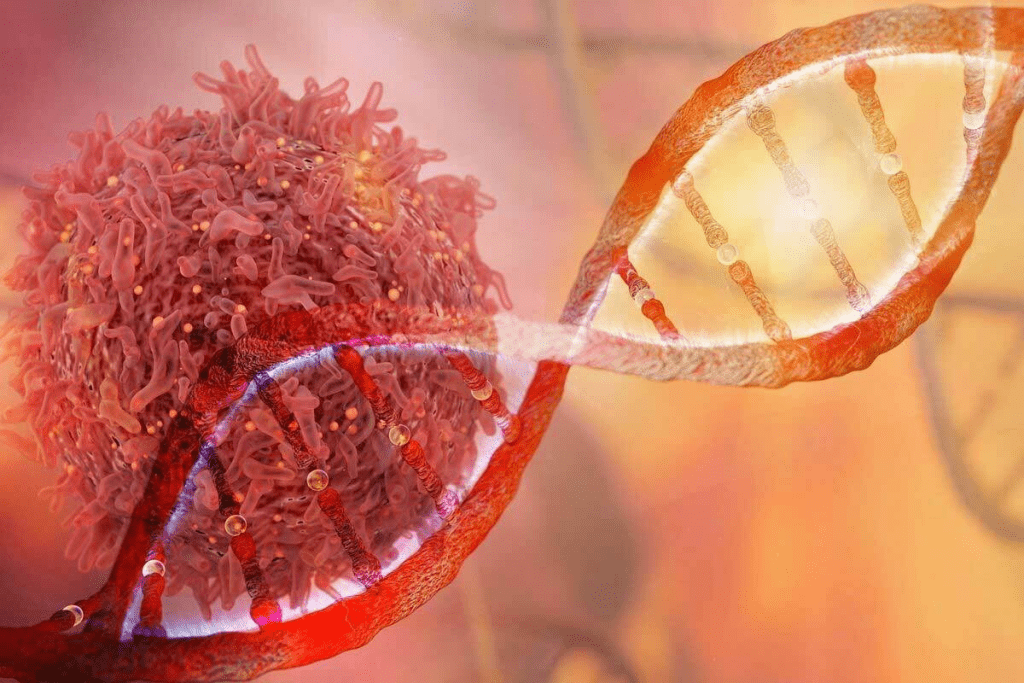Last Updated on November 27, 2025 by Bilal Hasdemir

We are seeing a big change in cancer care with new therapies. One of these is hyperthermia therapy. It’s a non-invasive breakthrough treatment that melts cancer by heating cancer cells to 40-45 °C. This stops them from repairing and kills them.
Studies show hyperthermia therapy works well for many cancers. This includes skin, brain, and rectal cancers. As we look at new research, we see hope for patients all over the world.
Key Takeaways
- Hyperthermia therapy is a non-invasive breakthrough cancer treatment.
- It raises the temperature of cancer cells to 40-45 °C, causing cell death.
- Effective in treating various types of cancer, including skin and brain cancers.
- Promising results in clinical trials for rectal cancer.
- A significant shift in cancer care with innovative therapies.
The Revolutionary World of Cancer-Melting Therapies
Medical research has made big strides in cancer treatments. We’re seeing a big change in how we fight cancer. Now, treatments aim to target and kill cancer cells directly.
Understanding How Modern Treatments Target and Eliminate Cancer Cells
Today’s cancer treatments are more precise. They aim to harm fewer healthy cells while attacking cancer. Hyperthermia therapy is one such treatment. It uses heat to melt away tumors.
Immunotherapy is another breakthrough. It boosts the body’s immune system to fight cancer better. This includes cancers like rectal and glioblastoma.
| Therapy Type | Mechanism of Action | Cancer Types Treated |
| Hyperthermia Therapy | Applies heat directly to the tumor site | Various solid tumors |
| Immunotherapy | Enhances the body’s immune response | Rectal cancer, glioblastoma, others |
| Radiofrequency Ablation | Uses radio waves to generate heat | Liver, kidney, and skin cancers |
The Paradigm Shift in Cancer Treatment Approaches
Old cancer treatments were often invasive. They included surgeries, chemotherapy, and radiation. These methods are effective but can cause serious side effects. New treatments aim to reduce these side effects while keeping their effectiveness.
Clinical trials are showing surprising results. Unexpected drugs found to reverse cancers for many patients. This is giving new hope to those who didn’t respond to traditional treatments.
As we learn more about these new therapies, we’re getting closer to a better future. Cancer treatment will be more effective, less invasive, and tailored to each patient’s needs.
Hyperthermia Therapy: A Treatment That Melts Cancer Through Targeted Heat

Hyperthermia therapy is a new way to fight cancer. It uses heat to melt tumors. This method works well on skin and brain cancers.
Heat is applied directly to the tumor. This stops cancer cells from repairing themselves. Eventually, the cells die.
How Precisely Delivered Heat Destroys Malignant Cells
Hyperthermia therapy’s success comes from its precise heat delivery. Advanced technologies target the tumor without harming healthy tissue. The heat damages cancer cells’ proteins and structures. This makes them easier to kill with other treatments.
New heating technologies are improving hyperthermia therapy. They allow for better temperature control and tumor targeting. For example, hyperthermia therapy can be part of a complete cancer treatment plan.
The Science Behind 40-45 °C Temperature Targeting
Cancer cells are very sensitive to heat. Heating them to 40-45 °C disrupts their metabolism, causing death. This temperature is just right to harm cancer cells without harming healthy tissue.
Temperature control is key in hyperthermia therapy. Advanced thermometry keeps the temperature just right. This ensures effective treatment with fewer side effects.
Radiofrequency Ablation: Precision Tumor Melting Technology
Radiofrequency ablation is changing cancer care by melting tumors away precisely. It’s a minimally invasive treatment that uses radio waves to heat up and kill cancer cells. This makes it a key tool in fighting cancer.
Tumor Destruction Through Heat Generation
Radiofrequency ablation uses electrical energy to heat tumors. This heat kills the cancer cells. It’s precise, so it targets tumors without harming healthy tissue nearby.
Key Benefits of Radiofrequency Ablation:
- Minimally invasive procedure
- Precision targeting of tumors
- Reduced risk of damage to surrounding tissue
- Effective for various types of cancer
Applications in Cancer Treatment
Radiofrequency ablation works well for liver, kidney, and skin cancers. It has shown great success in these areas. This gives hope to patients with these cancers.
| Cancer Type | Success Rate of RFA | Benefits |
| Liver Cancer | 80-90% | Minimally invasive, preserves liver function |
| Kidney Cancer | 85-95% | Reduces the need for surgical removal of the kidney |
| Skin Cancer | 90-95% | Effective for early-stage skin cancers, cosmetically favorable |
Research is ongoing to see how far radiofrequency ablation can go in cancer treatment. It’s being used with other therapies. This new approach is improving patient outcomes and quality of life.
Laser Interstitial Thermal Therapy (LITT): The Breakthrough Cancer Treatment That Melts Brain Tumors
LITT is a new hope for those with brain tumors that can’t be removed. It uses laser technology to heat and kill cancer cells. This method is precise and effective.
Neuro-oncology is seeing big steps forward with LITT. It targets brain tumors with great accuracy, harming less of the healthy tissue. MRI guidance helps place the laser and watch the treatment in real-time.
MRI-Guided Precision for Previously Inoperable Brain Tumors
Using MRI with LITT means precise temperature control. Doctors can watch the treatment area live. This makes sure the tumor gets hot enough without harming nearby important areas.
Clinical trials have shown promising results for brain tumors treated with LITT. Patients who couldn’t have surgery before are now seeing big improvements. Their tumors shrink, and their quality of life gets better.
Clinical Cases Where Brain Tumors Melted Away
Many cases show LITT’s success in treating brain tumors. For example, a study in a top medical journal showed a patient’s tumor was greatly reduced with LITT.
| Tumor Type | Treatment Outcome | Follow-Up Period |
| Glioblastoma | Significant tumor reduction | 6 months |
| Metastatic Brain Tumor | Complete tumor ablation | 12 months |
| Recurrent Glioma | Partial tumor reduction | 9 months |
These examples show LITT’s power to help patients with brain tumors. As research goes on, we expect even more progress in this groundbreaking treatment.
Microwave Ablation: Next-Generation Cancer Treatment That Melts Tumors Away
We are seeing a big change in cancer treatment with microwave ablation. This technology is changing how we remove tumors. It uses heat to melt away cancer cells.
How Microwave Energy Liquefies Cancer Cells
Microwave ablation uses microwave energy to target tumors. This energy heats the cancer cells until they are destroyed. It’s precise, so it doesn’t harm healthy tissue nearby.
To start, a thin antenna is inserted into the tumor. It sends out microwave energy, heating the tumor from the inside. This heat is so strong, it kills the cancer cells, which are then removed by the body.
Advantages Over Traditional Ablation Methods
Microwave ablation has many benefits over older methods like radiofrequency ablation. It can reach higher temperatures faster, leading to quicker and more effective treatment.
- Faster treatment times due to higher temperatures achieved more quickly
- Ability to treat larger tumors in a single session
- Less procedural pain due to the minimally invasive nature of the treatment
It can also treat tumors in different places, like the liver, kidney, and lung. Its ability to treat various tumors makes it a great option for many patients.
Microwave ablation is a leading technology in cancer treatment. It’s precise, effective, and has few side effects. It’s leading the way to new cancer treatments.
High-Intensity Focused Ultrasound (HIFU): Non-Invasive Cancer Melting
High-Intensity Focused Ultrasound (HIFU) is a new way to fight cancer. It uses sound waves to melt tumors without surgery. This method is getting a lot of attention for treating different cancers without cuts.
Sound Waves That Make Tumors Melt Away
HIFU uses sound waves to heat tumors, killing cancer cells. It does this carefully so healthy tissues stay safe. Doctors use MRI or ultrasound to guide the treatment for better results.
Key Benefits of HIFU:
- Non-invasive, reducing the risk of complications
- Minimal recovery time, allowing patients to return to normal activities quickly
- Precision targeting of tumors, sparing healthy tissue
Applications in Prostate, Rectal, and Cervical Cancers
HIFU is showing great results in treating prostate, rectal, and cervical cancers. It’s a good choice for those who can’t have surgery because of age or health issues.
| Cancer Type | HIFU Application | Benefits |
| Prostate Cancer | Precision targeting of prostate tumors | Preserves urinary and sexual function |
| Rectal Cancer | Non-invasive treatment of rectal tumors | Reduces the risk of complications associated with surgery |
| Cervical Cancer | Targeted destruction of cervical tumors | Minimally invasive, reducing recovery time |
As research goes on, HIFU’s uses are growing. It’s changing how we treat cancer, making treatments less invasive.
Nanoparticle-Enhanced Thermal Therapy: Microscopic Cancer Fighters
Engineered nanoparticles are changing cancer treatment. They offer a precise way to heat and kill cancer cells. This therapy is showing great promise in fighting different cancers, giving hope to patients everywhere.
Targeted Heating Through Engineered Particles
Nanoparticle-enhanced thermal therapy uses special nanoparticles that find cancer cells. These particles get heated by an outside source. This kills the cancer cells without harming the healthy tissue around them.
This method is very precise. It targets cancer cells directly. This reduces the side effects seen with traditional treatments.
Breakthroughs in Gold Nanoparticle Technology
Gold nanoparticles are a big deal in this therapy. They are great at absorbing and turning external energy into heat. This heat kills the cancer cells.
| Characteristics | Gold Nanoparticles | Other Nanoparticles |
| Heat Conversion Efficiency | High | Variable |
| Biocompatibility | Excellent | Good |
| Targeting Capability | Highly Specific | Specific |
The table shows why gold nanoparticles are great for thermal therapy. They convert heat well and are safe for the body. They are perfect for this job.
As research goes on, we’ll see even better treatments. These could help fight many types of cancer more effectively.
Unexpected Drugs Found to Reverse Cancers For Many
Recent breakthroughs in cancer research have led to the discovery of unexpected drugs that can reverse cancers in many patients. This exciting development has opened new avenues for cancer treatment, giving hope to patients who may not have responded to traditional therapies. We will explore how these unexpected drugs work and their role in melting away tumors.
Repurposed Medications With Surprising Cancer-Fighting Properties
Researchers have been studying various existing medications for their cancer-fighting properties. Some of these medications, originally designed for other purposes, have shown surprising efficacy in combating cancer cells. For instance, certain anti-inflammatory drugs and antibiotics have been found to have anti-cancer effects.
One of the most promising areas of research involves the use of repurposed medications that can target specific cancer cells without harming healthy tissue. This targeted approach not only improves the effectiveness of the treatment but also reduces the risk of side effects.
How These Drugs Make Tumors Melt Away
The process by which these repurposed medications melt away tumors involves complex biological mechanisms. These drugs work by either inhibiting the growth of cancer cells or inducing apoptosis (cell death). Some medications may also cut off the supply of nutrients and oxygen to the tumor, effectively starving it.
Let’s examine some of the most promising repurposed medications and their effects on various types of cancer:
| Medication | Original Use | Cancer-Fighting Effect |
| Aspirin | Pain relief, anti-inflammatory | Reduces risk of colorectal cancer |
| Metformin | Type 2 diabetes treatment | May reduce the risk of breast, prostate, and other cancers |
| Propranolol | Beta-blocker for hypertension | May inhibit the growth of certain tumors |
These findings are significant because they offer new treatment options for patients. By repurposing existing medications, researchers can potentially shorten the development time for new cancer treatments and make them more accessible to those in need.
As research continues, we can expect to see more breakthroughs in the use of unexpected drugs to combat cancer. The vast possibilities for these medications to improve patient outcomes are exciting, and we remain hopeful for the future of cancer treatment.
Magnetic Hyperthermia: New Cancer Treatment That Melts Tumors Even in Difficult Locations
Magnetic hyperthermia is a big step forward in cancer treatment. It gives hope to those with tumors in hard-to-reach spots. This therapy uses magnetic nanoparticles to heat tumors, melting them away. It’s changing how we fight cancer with new tech.
Nanoparticles That Heat Up Inside Tumors
The heart of magnetic hyperthermia is magnetic nanoparticles. These particles heat up in an alternating magnetic field. They’re made to find cancer cells, so the heat goes straight to the tumor.
This method is precise, protecting healthy tissues. It lowers the chance of side effects. Research shows it works on many cancers.
Targeted Delivery Systems Minimizing Side Effects
Magnetic hyperthermia’s targeted delivery system is a big plus. It uses nanoparticles linked to cancer-specific antibodies. This ensures the heat goes only to the tumor.
This approach boosts treatment success and cuts down on side effects. It keeps healthy tissues safe. This makes magnetic hyperthermia a strong tool against cancer.
| Benefits of Magnetic Hyperthermia | Description |
| Targeted Treatment | Specifically targets cancer cells, reducing damage to healthy tissues |
| Minimally Invasive | Avoids the need for surgical intervention, reducing recovery time |
| Effective for Difficult Locations | Can treat tumors in areas that are challenging to access surgically |
As research grows, magnetic hyperthermia will play a bigger role in cancer fights. It’s great for treating tumors in hard spots with few side effects. It’s a valuable addition to cancer treatments.
Conclusion: The Future of Cancer Treatments That Melt Tumors Away
The future of cancer care is changing fast. Researchers are working hard to find new ways to treat cancer. They aim to melt tumors away, giving patients new hope.
Recently, new treatments like hyperthermia therapy and nanoparticle-enhanced thermal therapy have shown great promise. These methods are leading the way in cancer treatment.
These new treatments are changing how we fight cancer. We can expect even better treatments in the future. The focus is on treatments that are targeted and don’t harm as much, improving patient outcomes.
Looking ahead, new and innovative therapies will be key in the fight against cancer. By keeping up with these advancements, we can aim for a future where cancer is no longer a death sentence.
FAQ
What is hyperthermia therapy, and how does it melt tumors away?
Hyperthermia therapy heats cancer cells to 40-45 °C. This disrupts their repair and causes death. It melts tumors away.
How does radiofrequency ablation work in cancer treatment?
Radiofrequency ablation uses radio waves to heat and destroy tumors. It melts them away effectively.
What is laser interstitial thermal therapy (LITT), and how is it used in brain cancer treatment?
LITT uses MRI to guide heat to brain tumors. It melts them away, helping with tumors that can’t be removed.
How does microwave ablation compare to traditional ablation methods?
Microwave ablation uses microwave energy to liquefy cancer cells. It’s more effective and quicker than traditional methods.
What is high-intensity focused ultrasound (HIFU), and how is it used in cancer treatment?
HIFU uses sound waves to melt away tumors. It treats cancers like prostate, rectal, and cervical cancers without surgery.
How does nanoparticle-enhanced thermal therapy work in cancer treatment?
This therapy uses particles to target and heat cancer cells. It’s a new way to melt tumors away.
What are unexpected drugs that have been found to reverse cancers, and how do they work?
Clinical trials have found drugs that fight cancer. They offer hope by making tumors melt away.
What is magnetic hyperthermia, and how is it used in cancer treatment?
Magnetic hyperthermia heats tumors with magnetic nanoparticles. It’s precise and minimizes side effects.
Are these cancer treatments available worldwide?
Some treatments are global, but others might be in trials or limited. Talk to a doctor for options.
What is the future of cancer treatments that melt tumors away?
Cancer care is changing fast. New treatments like hyperthermia and immunotherapy offer hope against cancer.
References
- Hohneck, A. L., et al. (2025). Effectiveness and safety of whole-body hyperthermia in cancer patients: A retrospective analysis. International Journal of Hyperthermia, 41(6), 1234-1249. https://www.ncbi.nlm.nih.gov/pmc/articles/PMC12384354/
- Zhu, W., et al. (2024). The role of hyperthermia in tumor treatment and synergy with radiotherapy and chemotherapy. Critical Reviews in Oncology/Hematology, 153, 103080. https://www.sciencedirect.com/science/article/abs/pii/S1040842824002841






